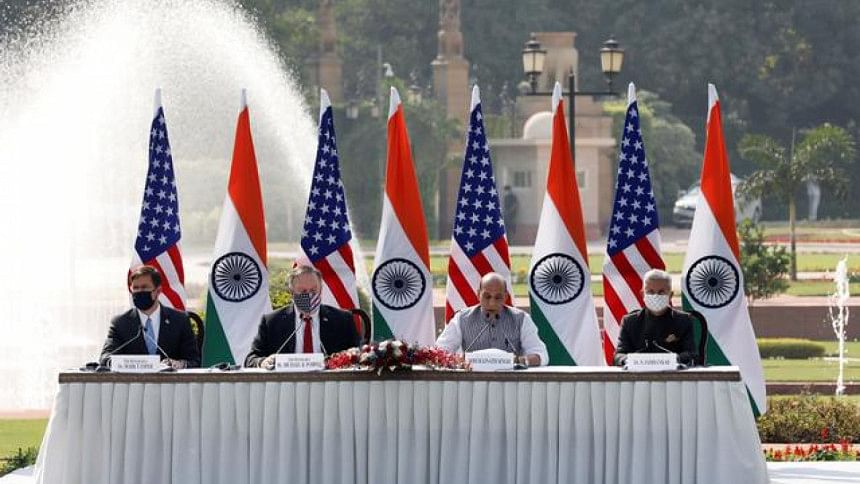Pompeo-Espar visit to India: China and beyond

China loomed large over the in-person visit of US Secretary of State Mike Pompeo and Defence Secretary Mark T Esper to New Delhi on October 26-27. They held talks with their Indian counterparts S Jaishankar and Rajnath Singh in what has been institutionalised as a 2+2 format which began just two years ago with the backing of Prime Minister Narendra Modi and President Donald Trump.
Analysts took note of three most striking aspects of the Pompeo-Esper visit: one, the two officials came to New Delhi in the midst of the coronavirus pandemic when most of the diplomatic engagements are through virtual mode and second, they came just a week before the US Presidential poll in what appears to be a very close race for the White House and third the unmissable background of India's tense military faceoff with China in Ladakh. But all three served to reinforce the view the bilateral relationship and send a strong signal of renewal and continuity that would survive change of guard in Washington, like it has done for most part of the history of India-US relationship.
The most significant takeaway from the Pompeo-Esper visit was of course the signing of Basic Exchange and Cooperation Agreement (BECA) which will allow India to use US geospatial intelligence and enhance accuracy of automated systems and weapons like missiles and armed drones. It will give access to topographical and aeronautical data and advanced products which will aid navigation and targeting.
Ever since India and the US signed the General Security of Military Information Agreement in 2002, the Indo-US defence ties have been on the rise. In June 2016, the US had designated India a "major defence partner" seeking to elevate defence trade and technology sharing to a level of Washington's closest partners. The two countries inked the Logistics Exchange Memorandum of Agreement (LEMOA) in 2016 that allows their militaries use each other's bases for repair and replenishment of supplies as well as provide for deeper cooperation. Two years down the line, the two countries signed another pact called COMCASA (Communications Compatibility and Security Agreement) that provides for interoperability between the two militaries and provides for sale of high-end technology from the US to India. The BECA completes the four key foundational pacts that would form the pillar of the strategic military ties between the two countries.
During the Cold War decades, anti-Americanism was prevalent in large parts of India as New Delhi firmly believed in hedging and balancing its ties with the world super powers, particularly the US, under the rubric of Non-Alignment. But all that changed since India conducted its second nuclear test in May, 1998 that an Indian diplomat said was the best thing to have happened to India's foreign policy profile. Initially triggering harsh response from the US and its allies, the test led to India's integration with the global nuclear order ironically with some hand-holding by the US.
There has always been a bipartisan support both in the US and India on closer bilateral ties even though there were some bad phases in between, including the worst one being during the Richard Nixon years in the White House and resistance by the Bill Clinton regime to the Indo-US civil nuclear deal on the ostensible ground of nuclear non-proliferation. If it was the right-wing BJP government under Prime Minister Atal Bihari Vajpayee that began engaging with the US on the nuclear issue in late 1990s, the work was completed by a Left-of-the-Centre dispensation headed by Manmohan Singh in 2005 even at the risk of losing the support of the Left parties for the Congress-led UPA coalition.
Both Vajpayee and Manmohan recognised the importance of the deal and India's presence at the global high table. Strategic Affairs analyst C Raja Mohan points out in an article in The Indian Express how Barrack Obama had, as a Senator, opposed the Indo-US nuclear but once in the White House as Democrat President hastened its operationalisation.
There are two main factors contributing to the drastic transformation in the geo-strategic outlook. India's first serious departure from its Non-Aligned stand, the 1971 Indo-Soviet treaty and the Bangladesh Liberation War, was a response to the American tilt towards Pakistan in the 70s and the beginnings of a Sino-American entente. Now, the rise of a militarily powerful China and its belligerent posturing across Asia that has pushed India to a closer strategic embrace with the US.
On the other hand, both Joe Biden and Trump recognise the threat from China although their response are different. While Trump may be willing to even more aggressively counter China, Biden is likely to follow a policy of what one analyst termed as containment-cum-engagement.
During a meeting with Republican President George W Bush in Washington in September, 2008, Manmohan Singh had gone public with his admiration for the former. In words so uncharacteristic in India's diplomatic parlance particularly under a Left-of-the-Centre government Singh said "the people of India deeply love you. And all that you have done to bring our two countries closer to each other is something history will remember." Yet, it remains inscrutable why the Manmohan Singh government had shied away from signing BECA, LEMOA and COMCASA which had been in discussions for over a decade. Was it because a strategic embrace with the US would affect India's strategic autonomy or because New Delhi did not want to provoke China at that time?
The China factor has always been a catalyst in India-US relations but never as pronounced as it is today. That factor was also common in the utterances of the Indian and American officials after the 2+2 talks in New Delhi. But the marked contrast was that while Pompeo and Esper repeatedly named China and the threat posed by Beijing, Jaishankar and Rajnath said as much without even once mentioning China. That is so typical of the diplomatic culture of the two countries over the years.
Pompeo came to New Delhi for thee 2+2 talks leading a charge against China's belligerence in Ladakh and South China Sea. The tone and tenor of his visit was set by the telephone call between Pompeo and Jaishankar in June after the June 14 Galwan Valley clash with Chinese troops in Ladakh where which 20 Indian soldiers were killed. That incident found its echo when the Secretary of State visited the National War Memorial in New Delhi and recalled the Galwan episode to send an unequivocal message that the US stands by India to defend its sovereignty.
India's China policy, it is argued by some analysts, would have to be coordinated with the US as India seems to be shifting from hedging its ties with China to balancing. But given the clear military and economic asymmetry between India and China, New Delhi is not in a position to balance China on its own and needs to go for a coalition with the US and other like-minded countries. Hence, the significance of the Quadrilateral involving the US, Japan, Australia and India with their cooperation in a range of activities, including military and economic, picking up pace in recent months and the formation of the Five Eyes featuring the US, New Zealand, Australia, Japan and India which held its last meeting in Tokyo in October.
That India-US relationship is not just about balancing China in strategic terms in the Indo-Pacific region comes out quite clearly in the joint statement issued after Pompeo-Espar visit. The document sweeps across a range of economic issues including reducing dependence on China for trade and manufacturing, building a sustainable global supply chain and transparent infrastructure financing in small developing countries avoiding the debt trap witnessed in China's Belt and Road initiative particularly in Sri Lanka. It would require a Herculean effort on the part of India, the US, Japan and Australia to match the kind of China's BRI extending from South Asia to Africa.
Pallab Bhattacharya is a special correspondent of The Daily Star. He writes from New Delhi, India.

 For all latest news, follow The Daily Star's Google News channel.
For all latest news, follow The Daily Star's Google News channel. 



Comments